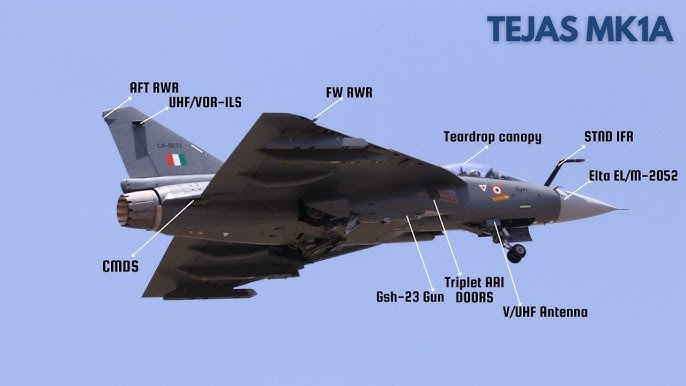SOURCE: RAUNAK KUNDE / NEWS BEAT / IDRW.ORG


The Indian Air Force (IAF) is set to place an order for a second batch of 97 Tejas Mk1A Light Combat Aircraft (LCA) next year, with production slated to begin in early 2028 and targeted for completion by 2032. According to sources cited by idrw.org, this batch will incorporate further improvements aimed at boosting the indigenous content of the aircraft while addressing initial feedback from the first batch deliveries expected later this year. These enhancements, including new software upgrades and the integration of locally developed weapons systems, are poised to elevate the combat capabilities of the Tejas Mk1A, reinforcing its role as a cornerstone of India’s indigenous defense ecosystem.
A key focus of the second batch is to increase the indigenous content of the Tejas Mk1A, which currently stands at around 60%. Hindustan Aeronautics Limited (HAL), in collaboration with the Aeronautical Development Agency (ADA) and private sector partners, plans to replace several imported Line Replaceable Units (LRUs) with domestically developed alternatives. While specific LRUs targeted for indigenization have not been disclosed, components such as avionics, sensors, and electronic systems are likely candidates, given ongoing efforts under the Aatmanirbhar Bharat initiative to reduce reliance on foreign suppliers.
This push for indigenization aligns with the IAF’s long-term goal of achieving self-reliance in defense manufacturing, particularly as geopolitical tensions in the region underscore the need for a robust indigenous supply chain. By increasing local content, HAL aims to lower lifecycle costs, improve supply chain resilience, and enhance the aircraft’s export potential, which has already garnered interest from many countries.
The first batch of Tejas Mk1A aircraft, with deliveries commencing later this year, will provide valuable operational feedback that HAL intends to integrate into the second batch. While the core design of the Mk1A—featuring an advanced AESA radar, improved electronic warfare suite, and mid-air refueling capability—remains robust, minor modifications are expected to address any identified shortcomings. These could include ergonomic improvements in the cockpit, enhanced maintainability, or tweaks to the airframe for better performance.
A significant upgrade planned for the second batch is the introduction of new software updates to the aircraft’s mission computer and avionics suite. These updates will enable the integration of additional indigenous weapons systems, further enhancing the Tejas Mk1A’s combat versatility. Weapons like the Astra Mk1 beyond-visual-range air-to-air missile, the Rudram anti-radiation missile, and the Smart Anti-Airfield Weapon (SAAW) are already integrated or in the process of being certified. The new software could facilitate the addition of next-generation munitions, such as the Astra Mk2 or precision-guided bombs under development by the Defence Research and Development Organisation (DRDO), expanding the jet’s role in air-to-air and air-to-ground missions.
The order for the second batch of 97 Tejas Mk1A aircraft, expected to be formalized in 2026, will bring the total number of Mk1A jets in the IAF’s inventory to 137, including the initial 40-unit order placed in 2021. Production is scheduled to commence in early 2028, with HAL aiming to deliver all 97 aircraft by 2032 at a rate of approximately 16-20 jets per year. To meet this timeline, HAL is ramping up its production capacity at its facilities in Bengaluru and Nashik, while also outsourcing sub-assemblies to private sector partners like Tata Advanced Systems and L&T to streamline manufacturing.
The Tejas Mk1A is a critical component of the IAF’s modernization strategy, aimed at replacing aging MiG-21, MiG-23, and MiG-27 fleets. With a 4.5-generation design, the Mk1A offers a cost-effective, multi-role platform capable of countering regional threats from Pakistan’s JF-17 Thunder and China’s J-10 fighters. Its compact size, low radar cross-section, and advanced avionics make it well-suited for operations in contested environments, particularly along India’s northern and western borders.
Despite the optimism surrounding the second batch, challenges remain. HAL’s production delays with the first batch, attributed to supply chain disruptions and engine delivery issues with General Electric’s F404-GE-IN20, have raised concerns about meeting future timelines. The indigenization of LRUs also requires rigorous testing and certification to ensure reliability, which could impact schedules if not managed effectively. Additionally, HAL’s manpower constraints, as highlighted by senior IAF officials, necessitate greater private sector involvement to sustain production momentum.
NOTE: Article cannot be reproduced without written permission of idrw.org in any form even for YouTube Videos to avoid Copy right strikes. Websites doing illegal reproductions will get DMCA and Legal Notices.